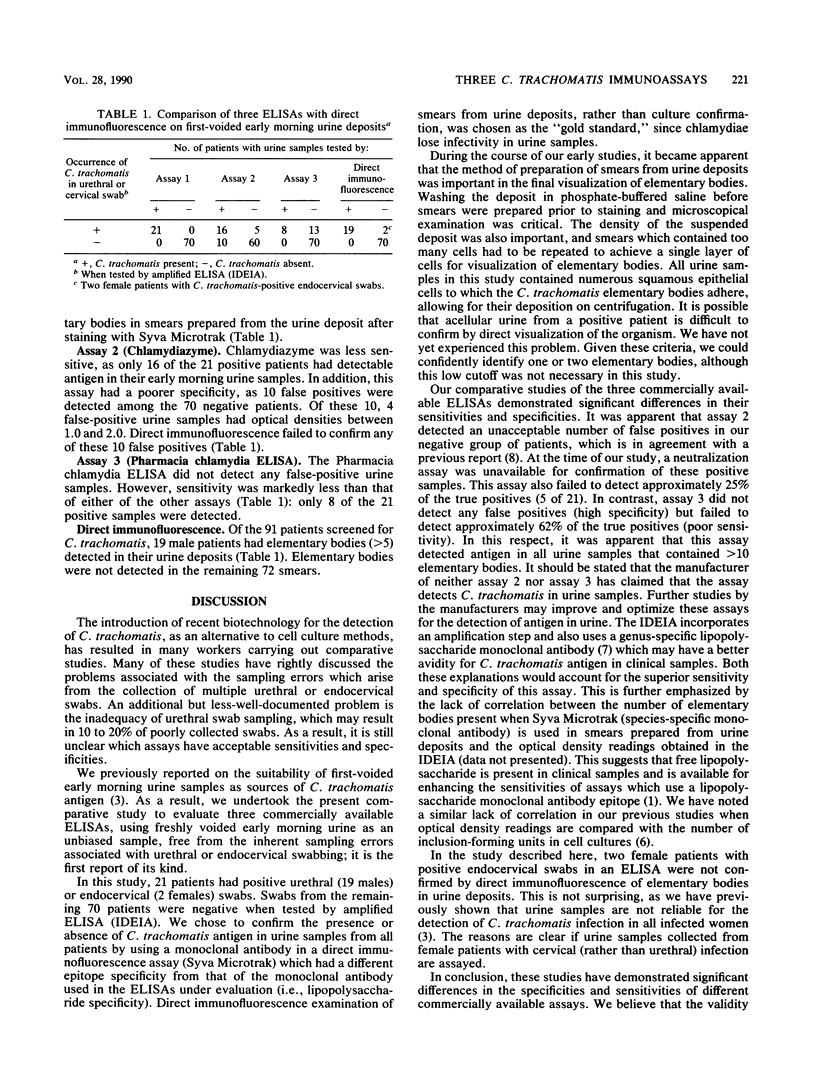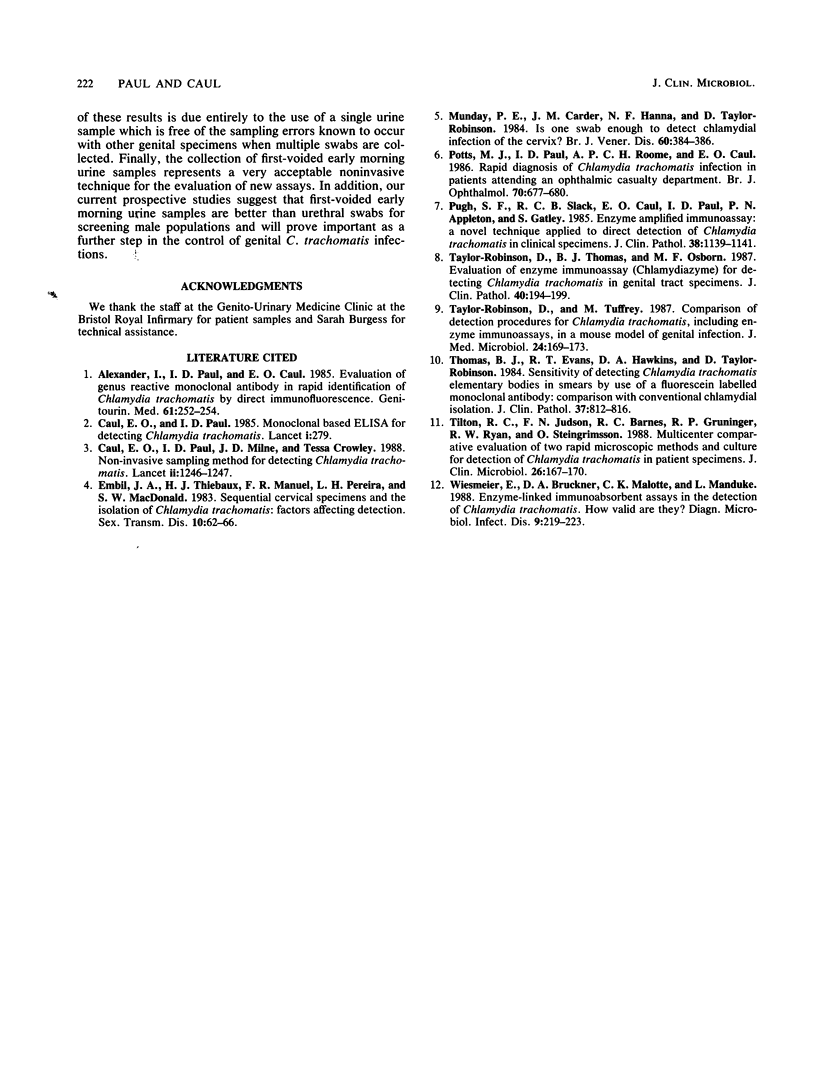Abstract
First-catch early morning urine samples from patients attending a genitourinary medicine clinic were tested by three different enzyme immunoassays. The results suggest significant differences in the sensitivities and specificities of the different assays. The direct visualization of elementary bodies in urine deposits by direct immunofluorescence was used as the "gold standard," using a monoclonal antibody with a different epitope specificity from those of antibodies used in the enzyme-linked immunosorbent assays. We report for the first time that urine specimens represent an unbiased sample, free of the inherent sampling errors associated with other genital specimens. We feel that urine is a valid specimen for use in any evaluation study of new assays directed towards the detection of Chlamydia trachomatis.
Full text
PDF


Selected References
These references are in PubMed. This may not be the complete list of references from this article.
- Alexander I., Paul I. D., Caul E. O. Evaluation of a genus reactive monoclonal antibody in rapid identification of Chlamydia trachomatis by direct immunofluorescence. Genitourin Med. 1985 Aug;61(4):252–254. doi: 10.1136/sti.61.4.252. [DOI] [PMC free article] [PubMed] [Google Scholar]
- Caul E. O., Paul I. D., Milne J. D., Crowley T. Non-invasive sampling method for detecting Chlamydia trachomatis. Lancet. 1988 Nov 26;2(8622):1246–1247. doi: 10.1016/s0140-6736(88)90831-8. [DOI] [PubMed] [Google Scholar]
- Caul E. O., Paul I. D. Monoclonal antibody based ELISA for detecting Chlamydia trachomatis. Lancet. 1985 Feb 2;1(8423):279–279. doi: 10.1016/s0140-6736(85)91056-6. [DOI] [PubMed] [Google Scholar]
- Embil J. A., Thiébaux H. J., Manuel F. R., Pereira L. H., MacDonald S. W. Sequential cervical specimens and the isolation of Chlamydia trachomatis: factors affecting detection. Sex Transm Dis. 1983 Apr-Jun;10(2):62–66. doi: 10.1097/00007435-198304000-00003. [DOI] [PubMed] [Google Scholar]
- Munday P. E., Carder J. M., Hanna N. F., Taylor-Robinson D. Is one swab enough to detect chlamydial infection of the cervix? Br J Vener Dis. 1984 Dec;60(6):384–386. doi: 10.1136/sti.60.6.384. [DOI] [PMC free article] [PubMed] [Google Scholar]
- Potts M. J., Paul I. D., Roome A. P., Caul E. O. Rapid diagnosis of Chlamydia trachomatis infection in patients attending an ophthalmic casualty department. Br J Ophthalmol. 1986 Sep;70(9):677–680. doi: 10.1136/bjo.70.9.677. [DOI] [PMC free article] [PubMed] [Google Scholar]
- Pugh S. F., Slack R. C., Caul E. O., Paul I. D., Appleton P. N., Gatley S. Enzyme amplified immunoassay: a novel technique applied to direct detection of Chlamydia trachomatis in clinical specimens. J Clin Pathol. 1985 Oct;38(10):1139–1141. doi: 10.1136/jcp.38.10.1139. [DOI] [PMC free article] [PubMed] [Google Scholar]
- Taylor-Robinson D., Thomas B. J., Osborn M. F. Evaluation of enzyme immunoassay (Chlamydiazyme) for detecting Chlamydia trachomatis in genital tract specimens. J Clin Pathol. 1987 Feb;40(2):194–199. doi: 10.1136/jcp.40.2.194. [DOI] [PMC free article] [PubMed] [Google Scholar]
- Taylor-Robinson D., Tuffrey M. Comparison of detection procedures for Chlamydia trachomatis, including enzyme immunoassays, in a mouse model of genital infection. J Med Microbiol. 1987 Sep;24(2):169–173. doi: 10.1099/00222615-24-2-169. [DOI] [PubMed] [Google Scholar]
- Tilton R. C., Judson F. N., Barnes R. C., Gruninger R. P., Ryan R. W., Steingrimsson O. Multicenter comparative evaluation of two rapid microscopic methods and culture for detection of Chlamydia trachomatis in patient specimens. J Clin Microbiol. 1988 Feb;26(2):167–170. doi: 10.1128/jcm.26.2.167-170.1988. [DOI] [PMC free article] [PubMed] [Google Scholar]
- Weismeier E., Bruckner D. A., Malotte C. K., Manduke L. Enzyme-linked immunoabsorbent assays in the detection of Chlamydia trachomatis: how valid are they? Diagn Microbiol Infect Dis. 1988 Apr;9(4):219–223. doi: 10.1016/0732-8893(88)90112-5. [DOI] [PubMed] [Google Scholar]


